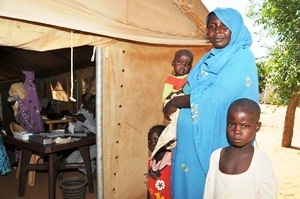 In Sudan, maternal and child health is a priority.
In Sudan, maternal and child health is a priority.
Unless there is additional funding bilaterally or through the Sudan Common Humanitarian Fund (CHF), more than 500 000 children under five years old will be at risk of the country’s big killers namely acute respiratory infections, measles, diarrhoea, malaria, malnutrition, as well as other vaccine-preventable diseases; and more than 130 000 pregnant women will have no access to maternal health care services such as ante-natal care, delivery assisted with skilled birth attendants, and emergency obstetric care.
The Health Sector’s overall appeal under the Strategic Response Plan (SRP) is US$ 68 million targeting 5.1 million people. These funds will help facilitate better access to basic primary health in camps, gatherings and affected host population and support prompt response to new crises of displacement, outbreaks or public health threats. To date, there is a gap of US$ 59 million to support health interventions to save more lives and support relief efforts.
Under the CHF, 33 eligible health partners submitted projects for US$ 28.7 million. However, due to the drop in CHF funding only 17 projects could be funded from an allocation of US$ 6.68 million complemented with US$ 2.5 million from Central Emergency Response Fund (CERF).
The Sudan CHF is a multi-donor pooled fund and supports the timely allocation and disbursement of funds to Sudan’s most critical humanitarian needs. This is a well-established mechanism that allows donors with no in-country presence or without technical staff to contribute to the humanitarian needs in the country. CERF is the United Nations’ central humanitarian fund to help speed-up relief efforts.
Health needs
According to Sudan’s Humanitarian Needs Overview (HNO), 69% of the country’s population have access to health services while only 24% of health facilities in these localities are providing the full package of basic/minimum health services. Physical accessibility to primary health care (PHC) facilities varies from 3039 people per facility in the Northern State to 20 779 people per facility in South Darfur while the national average per facility is 6816 compared to the planned 5000 population.
Additionally, there is a critical gap in reproductive health as only a third of the population has access to an adequate number of midwives providing reproductive health services. Only 9% of married women in the age range of 15 to 49 use contraceptives while the unmet need for family planning is estimated at 29%.
Many areas in Sudan are prone to emergencies with 21 localities categorized as highly prone, reporting more than three incidents of disease outbreaks and other health emergencies over the last three years.
In Darfur, the number of health partners has decreased since 2009; however, 41% of health facilities are managed by nongovernmental organizations. Most of these facilities are concentrated at camps and rural areas. In 2013, five NGOs pulled out leaving almost 30 health facilities poorly functional.
The Human Resource for Health situation in Sudan and especially in Darfur region and Protocol Areas are characterized by shortage and inequitable distribution of health cadres both at the state and locality levels. The density of physicians, nurses and midwives is 1.23 (FMoH 2012) against WHO standard benchmark of 2.28 per 1000 people, however, most of the staff categories concentrated at the main towns.
Related link



